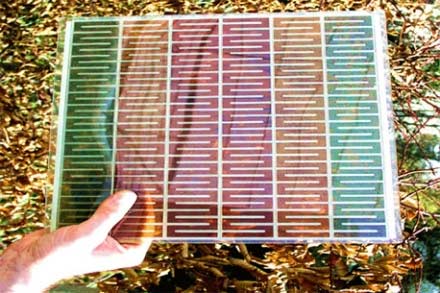The new dye-sensitised solar cells (DSSCs) are currently only half as efficient as traditional silicon-based alternatives, but come at one quarter of the cost. However, the team hopes to boost the cells' performance.
"We believe that one day, DSSC efficiency can reach levels comparable to any solar cell," said Yiying Wu, who led the research.
"The major advantage of DSSCs is that the cost is low. That is why DSSCs are so interesting to us, and so important."
The cells' pink colour results from a mixture of red dye and white metal oxide powder. DSSCs typically contain red ruthenium dyes and titanium oxide or zinc oxide, which are both whitish in colour.
The researchers' latest prototypes, however, use a new material – zinc stannate, a more complex metal oxide with more adaptable properties.
"This opens up new possibilities for how scientists may tailor the properties of DSSCs in the future," explained Wu.
Silicon-based solar cells look blue because of an anti-reflective coating which boosts absorption of green light, the strongest in the solar spectrum.
Colour determines the wavelength of light that a solar cell can capture, so adjusting it allows scientists to optimise the device’s properties.
At this stage in the development of DSSCs, scientists have obtained the best performance from red ruthenium dye.
Dye molecules absorb energy from light
In DSSCs, dye molecules coat tiny metal oxide particles that are packed together into a thin film. The dye molecules absorb light energy and release electrons which are then conducted by the particles.
Electrons can get lost when travelling between particles, though. For this reason, the team is working on designs incorporating tiny nano-wires that will carry electrons directly to a circuit.
A prototype developed by the researchers last year contained particles and nano-wires of titanium oxide. That formulation achieved 8.6 per cent efficiency – roughly half of the 15 per cent efficiency typical of commercially available silicon solar cells.
The latest design employed zinc stannate particles but no nano-wires, achieving 3.8 per cent efficiency. In order to maximise performance, the team plans to combine these two techniques by making nano-wires from zinc stannate and other oxides.
They are also exploring the possibility of using nano-trees – nano-wires shaped like the branches of a tree.
"We asked ourselves, what structure is best for gathering light and also transporting materials – a tree!" Wu said.
In the proposed DSSC design, the dye-coated particles would provide a large surface area for light aborption, and the nano-trees would branch out in between them to transport the electrons..

